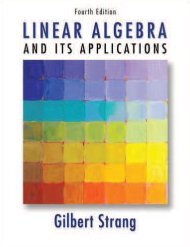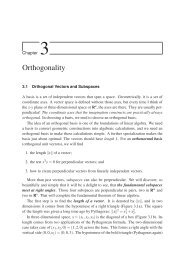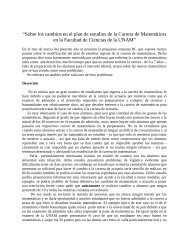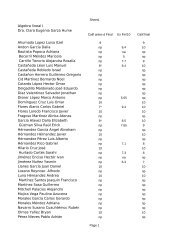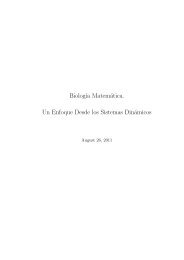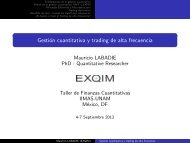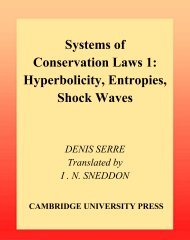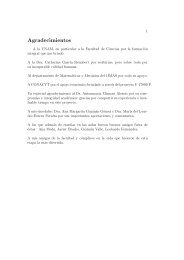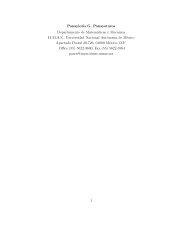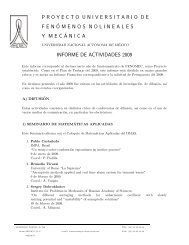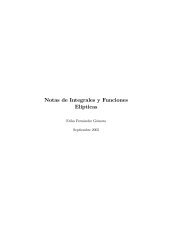- Page 1 and 2: Birkhäuser - Your Specialized Publ
- Page 3 and 4: To my wife Claire To Olivier, Aline
- Page 5 and 6: viii Part 2. CONTENTS SYSTEMS OF CO
- Page 7 and 8: x PREFACE No familiarity with hyper
- Page 9 and 10: CHAPTER I FUNDAMENTAL CONCEPTS AND
- Page 11 and 12: 1. HYPERBOLICITY, GENUINE NONLINEAR
- Page 13 and 14: 1. HYPERBOLICITY, GENUINE NONLINEAR
- Page 15 and 16: 1. HYPERBOLICITY, GENUINE NONLINEAR
- Page 17 and 18: 2. SHOCK FORMATION AND WEAK SOLUTIO
- Page 19 and 20: 2. SHOCK FORMATION AND WEAK SOLUTIO
- Page 21: 3. SINGULAR LIMITS AND THE ENTROPY
- Page 25 and 26: 4. EXAMPLES OF DIFFUSIVE-DISPERSIVE
- Page 27 and 28: 4. EXAMPLES OF DIFFUSIVE-DISPERSIVE
- Page 29 and 30: 4. EXAMPLES OF DIFFUSIVE-DISPERSIVE
- Page 31 and 32: 5. KINETIC RELATIONS AND TRAVELING
- Page 33 and 34: 5. KINETIC RELATIONS AND TRAVELING
- Page 35 and 36: CHAPTER II THE RIEMANN PROBLEM In t
- Page 37 and 38: 2. CLASSICAL RIEMANN SOLVER 31 To d
- Page 39 and 40: 2. CLASSICAL RIEMANN SOLVER 33 whil
- Page 41 and 42: 2. CLASSICAL RIEMANN SOLVER 35 (b)
- Page 43 and 44: 3. ENTROPY DISSIPATION FUNCTION 37
- Page 45 and 46: 3. ENTROPY DISSIPATION FUNCTION 39
- Page 47 and 48: 4. NONCLASSICAL RIEMANN SOLVER FOR
- Page 49 and 50: 4. NONCLASSICAL RIEMANN SOLVER FOR
- Page 51 and 52: 4. NONCLASSICAL RIEMANN SOLVER FOR
- Page 53 and 54: 5. NONCLASSICAL RIEMANN SOLVER FOR
- Page 55 and 56: 5. NONCLASSICAL RIEMANN SOLVER FOR
- Page 57 and 58: CHAPTER III DIFFUSIVE-DISPERSIVE TR
- Page 59 and 60: 2. KINETIC FUNCTIONS FOR THE CUBIC
- Page 61 and 62: 2. KINETIC FUNCTIONS FOR THE CUBIC
- Page 63 and 64: 2. KINETIC FUNCTIONS FOR THE CUBIC
- Page 65 and 66: 3. KINETIC FUNCTIONS FOR GENERAL FL
- Page 67 and 68: 3. KINETIC FUNCTIONS FOR GENERAL FL
- Page 69 and 70: 3. KINETIC FUNCTIONS FOR GENERAL FL
- Page 71 and 72: 3. KINETIC FUNCTIONS FOR GENERAL FL
- Page 73 and 74:
3. KINETIC FUNCTIONS FOR GENERAL FL
- Page 75 and 76:
4. TRAVELING WAVES FOR A GIVEN SPEE
- Page 77 and 78:
4. TRAVELING WAVES FOR A GIVEN SPEE
- Page 79 and 80:
4. TRAVELING WAVES FOR A GIVEN SPEE
- Page 81 and 82:
4. TRAVELING WAVES FOR A GIVEN SPEE
- Page 83 and 84:
5. TRAVELING WAVES FOR A GIVEN DIFF
- Page 85 and 86:
5. TRAVELING WAVES FOR A GIVEN DIFF
- Page 87 and 88:
CHAPTER IV EXISTENCE THEORY FOR THE
- Page 89 and 90:
1. CLASSICAL ENTROPY SOLUTIONS FOR
- Page 91 and 92:
1. CLASSICAL ENTROPY SOLUTIONS FOR
- Page 93 and 94:
1. CLASSICAL ENTROPY SOLUTIONS FOR
- Page 95 and 96:
2. CLASSICAL ENTROPY SOLUTIONS FOR
- Page 97 and 98:
2. CLASSICAL ENTROPY SOLUTIONS FOR
- Page 99 and 100:
3. NONCLASSICAL ENTROPY SOLUTIONS 9
- Page 101 and 102:
3. NONCLASSICAL ENTROPY SOLUTIONS 9
- Page 103 and 104:
3. NONCLASSICAL ENTROPY SOLUTIONS 9
- Page 105 and 106:
3. NONCLASSICAL ENTROPY SOLUTIONS 9
- Page 107 and 108:
3. NONCLASSICAL ENTROPY SOLUTIONS 1
- Page 109 and 110:
3. NONCLASSICAL ENTROPY SOLUTIONS 1
- Page 111 and 112:
3. NONCLASSICAL ENTROPY SOLUTIONS 1
- Page 113 and 114:
3. NONCLASSICAL ENTROPY SOLUTIONS 1
- Page 115 and 116:
3. NONCLASSICAL ENTROPY SOLUTIONS 1
- Page 117 and 118:
3. NONCLASSICAL ENTROPY SOLUTIONS 1
- Page 119 and 120:
4. REFINED ESTIMATES 113 In turn, w
- Page 121 and 122:
4. REFINED ESTIMATES 115 Therefore,
- Page 123 and 124:
4. REFINED ESTIMATES 117 provided t
- Page 125 and 126:
1. A CLASS OF LINEAR HYPERBOLIC EQU
- Page 127 and 128:
1. A CLASS OF LINEAR HYPERBOLIC EQU
- Page 129 and 130:
1. A CLASS OF LINEAR HYPERBOLIC EQU
- Page 131 and 132:
1. A CLASS OF LINEAR HYPERBOLIC EQU
- Page 133 and 134:
2. L 1 CONTINUOUS DEPENDENCE ESTIMA
- Page 135 and 136:
2. L 1 CONTINUOUS DEPENDENCE ESTIMA
- Page 137 and 138:
2. L 1 CONTINUOUS DEPENDENCE ESTIMA
- Page 139 and 140:
3. SHARP VERSION OF THE CONTINUOUS
- Page 141 and 142:
4. GENERALIZATIONS 135 where L(u, v
- Page 143 and 144:
PART 2 SYSTEMS OF CONSERVATION LAWS
- Page 145 and 146:
140 CHAPTER VI. THE RIEMANN PROBLEM
- Page 147 and 148:
142 CHAPTER VI. THE RIEMANN PROBLEM
- Page 149 and 150:
144 CHAPTER VI. THE RIEMANN PROBLEM
- Page 151 and 152:
146 CHAPTER VI. THE RIEMANN PROBLEM
- Page 153 and 154:
148 CHAPTER VI. THE RIEMANN PROBLEM
- Page 155 and 156:
150 CHAPTER VI. THE RIEMANN PROBLEM
- Page 157 and 158:
152 CHAPTER VI. THE RIEMANN PROBLEM
- Page 159 and 160:
154 CHAPTER VI. THE RIEMANN PROBLEM
- Page 161 and 162:
156 CHAPTER VI. THE RIEMANN PROBLEM
- Page 163 and 164:
158 CHAPTER VI. THE RIEMANN PROBLEM
- Page 165 and 166:
160 CHAPTER VI. THE RIEMANN PROBLEM
- Page 167 and 168:
162 CHAPTER VI. THE RIEMANN PROBLEM
- Page 169 and 170:
164 CHAPTER VI. THE RIEMANN PROBLEM
- Page 171 and 172:
166 CHAPTER VI. THE RIEMANN PROBLEM
- Page 173 and 174:
168 CHAPTER VII. CLASSICAL ENTROPY
- Page 175 and 176:
170 CHAPTER VII. CLASSICAL ENTROPY
- Page 177 and 178:
172 CHAPTER VII. CLASSICAL ENTROPY
- Page 179 and 180:
174 CHAPTER VII. CLASSICAL ENTROPY
- Page 181 and 182:
176 CHAPTER VII. CLASSICAL ENTROPY
- Page 183 and 184:
178 CHAPTER VII. CLASSICAL ENTROPY
- Page 185 and 186:
180 CHAPTER VII. CLASSICAL ENTROPY
- Page 187 and 188:
182 CHAPTER VII. CLASSICAL ENTROPY
- Page 189 and 190:
184 CHAPTER VII. CLASSICAL ENTROPY
- Page 191 and 192:
186 CHAPTER VII. CLASSICAL ENTROPY
- Page 193 and 194:
CHAPTER VIII NONCLASSICAL ENTROPY S
- Page 195 and 196:
190 CHAPTER VIII. NONCLASSICAL ENTR
- Page 197 and 198:
192 CHAPTER VIII. NONCLASSICAL ENTR
- Page 199 and 200:
194 CHAPTER VIII. NONCLASSICAL ENTR
- Page 201 and 202:
196 CHAPTER VIII. NONCLASSICAL ENTR
- Page 203 and 204:
198 CHAPTER VIII. NONCLASSICAL ENTR
- Page 205 and 206:
200 CHAPTER VIII. NONCLASSICAL ENTR
- Page 207 and 208:
202 CHAPTER VIII. NONCLASSICAL ENTR
- Page 209 and 210:
204 CHAPTER VIII. NONCLASSICAL ENTR
- Page 211 and 212:
206 CHAPTER VIII. NONCLASSICAL ENTR
- Page 213 and 214:
208 CHAPTER VIII. NONCLASSICAL ENTR
- Page 215 and 216:
210 CHAPTER VIII. NONCLASSICAL ENTR
- Page 217 and 218:
CHAPTER IX CONTINUOUS DEPENDENCE OF
- Page 219 and 220:
214 CHAPTER IX. CONTINUOUS DEPENDEN
- Page 221 and 222:
216 CHAPTER IX. CONTINUOUS DEPENDEN
- Page 223 and 224:
218 CHAPTER IX. CONTINUOUS DEPENDEN
- Page 225 and 226:
220 CHAPTER IX. CONTINUOUS DEPENDEN
- Page 227 and 228:
222 CHAPTER IX. CONTINUOUS DEPENDEN
- Page 229 and 230:
224 CHAPTER IX. CONTINUOUS DEPENDEN
- Page 231 and 232:
226 CHAPTER IX. CONTINUOUS DEPENDEN
- Page 233 and 234:
228 CHAPTER IX. CONTINUOUS DEPENDEN
- Page 235 and 236:
230 CHAPTER IX. CONTINUOUS DEPENDEN
- Page 237 and 238:
232 CHAPTER IX. CONTINUOUS DEPENDEN
- Page 239 and 240:
234 CHAPTER IX. CONTINUOUS DEPENDEN
- Page 241 and 242:
236 CHAPTER IX. CONTINUOUS DEPENDEN
- Page 243 and 244:
238 CHAPTER IX. CONTINUOUS DEPENDEN
- Page 245 and 246:
240 CHAPTER IX. CONTINUOUS DEPENDEN
- Page 247 and 248:
242 CHAPTER X. UNIQUENESS OF ENTROP
- Page 249 and 250:
244 CHAPTER X. UNIQUENESS OF ENTROP
- Page 251 and 252:
246 CHAPTER X. UNIQUENESS OF ENTROP
- Page 253 and 254:
248 CHAPTER X. UNIQUENESS OF ENTROP
- Page 255 and 256:
250 CHAPTER X. UNIQUENESS OF ENTROP
- Page 257 and 258:
252 CHAPTER X. UNIQUENESS OF ENTROP
- Page 259 and 260:
254 CHAPTER X. UNIQUENESS OF ENTROP
- Page 261 and 262:
256 CHAPTER X. UNIQUENESS OF ENTROP
- Page 263 and 264:
258 CHAPTER X. UNIQUENESS OF ENTROP
- Page 265 and 266:
260 APPENDIX if its total variation
- Page 267 and 268:
262 APPENDIX vector-valued Radon me
- Page 269 and 270:
BIBLIOGRAPHICAL NOTES Chapter I. Sm
- Page 271 and 272:
BIBLIOGRAPHICAL NOTES 267 with the
- Page 273 and 274:
BIBLIOGRAPHICAL NOTES 269 The exist
- Page 275 and 276:
BIBLIOGRAPHY Abeyaratne R. and Know
- Page 277 and 278:
BIBLIOGRAPHY 273 Baiti P., LeFloch
- Page 279 and 280:
BIBLIOGRAPHY 275 Chen G.-Q. and Kan
- Page 281 and 282:
BIBLIOGRAPHY 277 in “Nonlinear An
- Page 283 and 284:
BIBLIOGRAPHY 279 Fonseca I. (1989b)
- Page 285 and 286:
BIBLIOGRAPHY 281 Hattori H. (1986a)
- Page 287 and 288:
BIBLIOGRAPHY 283 Jenssen H.K. (2000
- Page 289 and 290:
BIBLIOGRAPHY 285 LeFloch P.G. (1988
- Page 291 and 292:
BIBLIOGRAPHY 287 Liu T.-P. (1974),
- Page 293 and 294:
BIBLIOGRAPHY 289 Oleinik O. (1957),
- Page 295 and 296:
BIBLIOGRAPHY 291 Serrin J. (1979),
- Page 297 and 298:
BIBLIOGRAPHY 293 Temple B. (1982),




